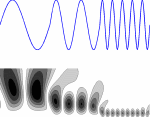HASSIP – Harmonic Analysis and Statistics for Signal and Image Processing
| Leadership: | Prof. Dr. Dr. h.c. Peter Maaß ((0421) 218-63801, E-Mail: pmaass@math.uni-bremen.de ) |
| Processor: | |
| Funding: | EU Research Training Network |
| Project partner: |
Laboratoire d'Analyse, Topologie et Probabilités, Marseille Laboratoire de Mécanique et d'Acoustique, Marseille Electrical Engineering Department, University of Campridge FYMA, Institut de Physique Théorique, Université Catholique de Louvain Laboratoire de Traitement du Signal, Ecole Polytechnique Fédéral de Lausanne Biomedical Imaging Group, Ecole Polytechnique Fédéral de Lausanne Mathematics Department, University of Marburg Institut für Biomathematik und Biometrie, Gesellschaft für Strahlenschutz, München Department of Electrical Engineering, Technion, Haifa |
| Time period: | since 01.11.2002 |
 HASSIP (Improving Human Potential and the Socio-Economic Knowledge Base. The objective of this network is to further the research and exchange activities in various areas of mathematical analysis and statistics which are closely related to digital signal and image processing.
HASSIP (Improving Human Potential and the Socio-Economic Knowledge Base. The objective of this network is to further the research and exchange activities in various areas of mathematical analysis and statistics which are closely related to digital signal and image processing.
Unlike the customary research carried out at an international level, the objective of the HASSIP programme is to create a higher level of academic integration. Hence, one of the declared objectives is to shorten the development cycles for new algorithms by bringing together those involved in the research: mathematicians and physicists working on the fundamentals with a view to their application, and engineers and users developing actual implementations of these algorithms. The primary objective is therefore to strengthen the link between research and application, between development and utilisation. New algorithms will be developed and their effect investigated using concrete examples. A further intention is to find new ways of eliminating the disadvantages of existing methods and to better adapt these methods to the requirements of concrete problems. This stimulates the research in these fields in general and further improves the link between theory and practice. From a mathematical point of view, the main topics are:
- Harmonic analysis, especially time-frequency and time-scale analysis.
- Statistics, with a particular emphasis on the statistical models for images and signals.
- Numerical analysis for image processing applications.
- Modelling and compression of audio signals.
- Encoding and compression of image and video data.
- Restoration and denoising of signals and images.
As part of the HASSIP programme, Massimo Fornasiers from Padua University spent six months from July 2003 as a visiting researcher collaborating with our staff and colleagues from Marburg University on research into general Banach frames for Coorbit spaces. A more application-oriented research team came into being in the course of a grant awarded by HASSIP to Mathias Lindemann, who spent three months at the Ecole Polytechnique Federale de Lausanne (EPFL) carrying out research into new methods of calculating EEG topography maps of the human head to diagnose dementia and schizophrenia.

Example of topography maps of the human head with measured EEG signals (joint project with the EPFL Lausanne). A matching pursuit method was used to approximate the 21 channels. The aim is to characterise areas with abnormal brain activity which, in turn, can provide information concerning illnesses in later life such as dementia and schizophrenia.

